Badami
+ Also see: my travel photography workshop in Badami
+ A version of this article was published in the July issue of Harmony Magazine
Nearly 1,500 years ago, the mighty Chalukya Kings discovered a small gap among the rocky cliffs situated in the parched plains of today’s North Karnataka, covered by steep sandstone walls in three directions with a small opening to the north-west. They found it to be a secure place to govern their kingdom from, built a large tank in a depression surrounded by cliffs on three sides, carved a few temples in those rocks and established the center of a dynasty that ruled for nearly 600 years to control a large chunk of land between Narmada and Kaveri.
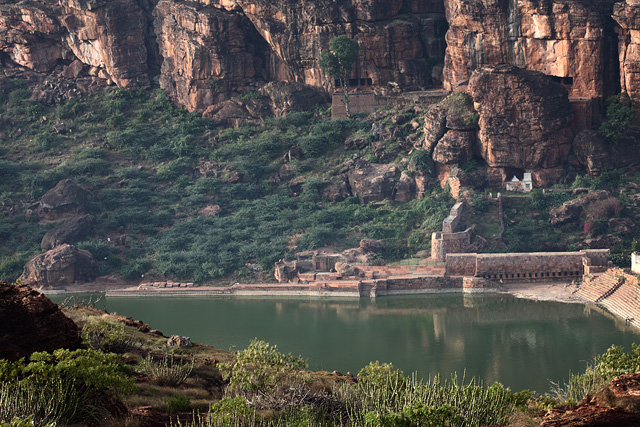
Cave temples and cliffs of Badami
This recorded history of Badami is interesting, but the mythology is even more fascinating. On his journey across the Vindhyas, Sage Agastya was invited by demons Vatapi and Ilvala for a meal. The brothers had the habit of calling guests home and kill them in the most innovative possible way. Vatapi would turn into a ram while Ilvala would cook its meat and offer to the guest. Once eaten, Vatapi would come out splitting the stomach of the guest, thus killing him. The story does not say why did they have to choose such circuitous route to achieve their mission, but it sure makes it very interesting.
But when it comes to legends, sages are always smarter than demons. Agastya knew the whole plan and digested Vatapi before he could come out, putting an end to the evils of the pair. Today, the cliffs around the Agastya Lake in Badami are believed to be the bodies of mighty demons who were defeated by the sage.
The legend would have brought some aura to the town, but it is the remains of history that attracted me here. Temples carved halfway up a cliff are the hallmark of Badami. Built by Chalukya Kings over a period of two centuries, they are among the best surviving structures of early Indian Architecture.
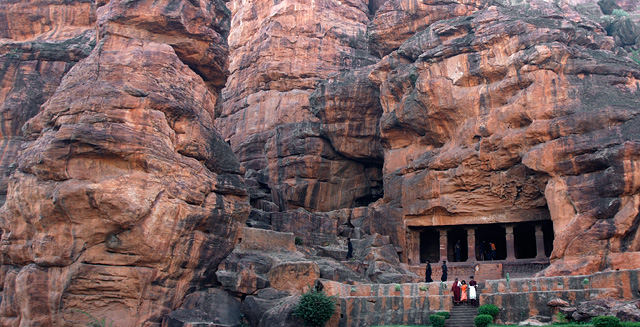
First of the four rock cut temples of Badami
There are four cave temples in Badami with three dedicated to Vedic Gods, the last one being a Jain Temple. The first three temples have some elaborate sandstone carvings of Hindu Pantheon such as Vamana stepping over Bali, dancing Nataraja, Varaha carrying Bhudevi and Vishnu seated on Vasuki. The Jain temple, smallest of the four has a series of Tirthankaras carved along the walls.
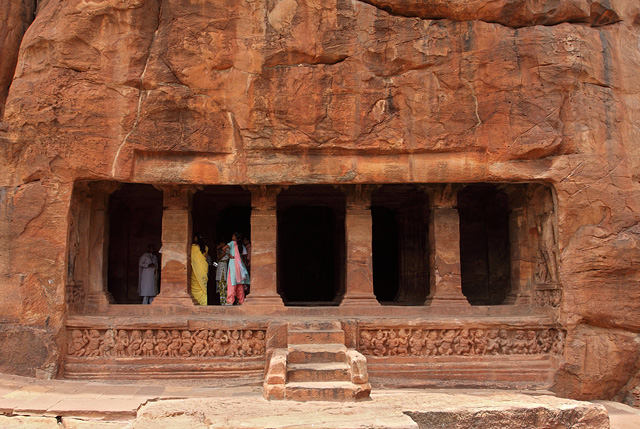
The rock cut temples
Chandru, my ASI certified guide at Badami, was knowledgeable and articulate. He stood in dance positions and held his hands in mudras when he described how the 18-handed statue of Nataraja can form 81 mudras in Bharatanatya by choosing any one of the left hands in combination with any of the right hands. We moved through caves as Chandru described the iconography and architecture, but my questions to him were mostly related to history.
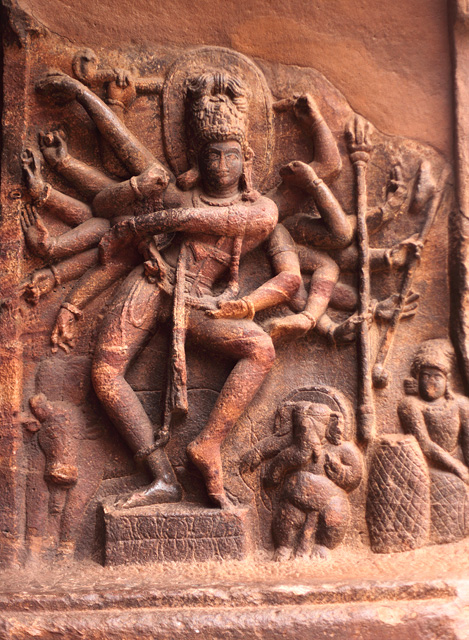
Nataraja relief in the first rock cut temple at Badami
The inscriptions in Badami and surrounding areas are a key to rediscovering most of the Chalukyan history. An inscription carved somewhere high up the rocks on the cliff opposite to the caves describes the times of the first Chalukyan Kings. Another inscription by Pallava King Narasimhavarman I informs of the brief occupation of Badami by Pallavas. A detailed inscription on a pillar at nearby Mahakoota Village, carved in the time of king Mangalesha, provides much needed information about the lineage of Chalukyas and the spread of their kingdom. An inscription in Aihole Village describe the victory of Pulikeshi II over Harshavardhana and another one gives vague clues about the existence and time period of renowned poet Kalidasa.
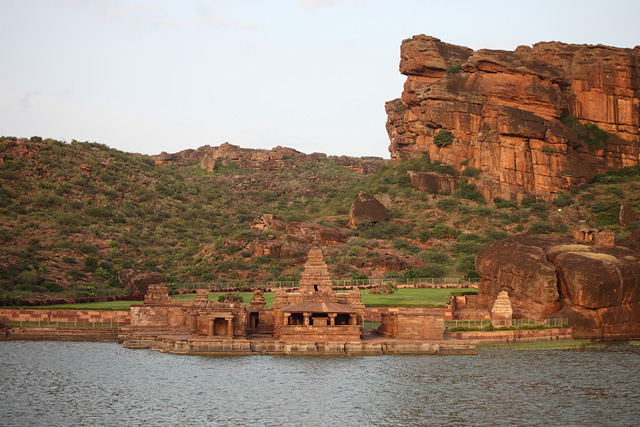
The grand setup of Bhoothanatha Temple, Badami
From my vantage point at these caves up in the hill, I could see the Bhoothanatha Temple at the edge of Agastya Lake. Unlike the cave temples that are full of visitors, the temple premises were empty, save for occasional drifting visitors. The Bhoothanatha Temple is in a grand setup, surrounded by walls of red sandstone rocks on three sides and the waters of the lake lapping up the steps in the front. Sitting in the temple courtyard that evening, I watched the cool breeze ruffling the lake surface as the evening sun disappear behind the town.
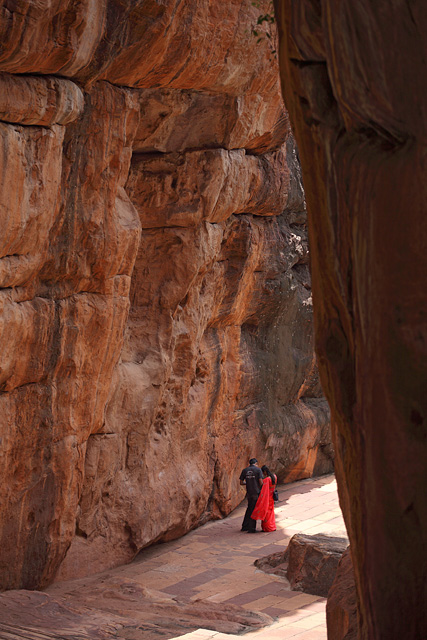
The narrow path through gaps in the sandstone walls of Badami
During my wanderings along the lake shore, I drifted towards the hills opposite to the caves and climbed a short flight of steps that took me up the table-land above. The steps climb through narrow gaps in the rocks that are wide enough at places just to let in a few people at a time. Sunlight peering through the gap and flaring up small sections of the wall make a colourful play of light and shade in these fissures. Up on the hill are a few temples, a few pillars and remains of a fort. Fortification of the hill must have been an easy task, as it mostly involved building walls to restrict entry through the cracks in the rock.
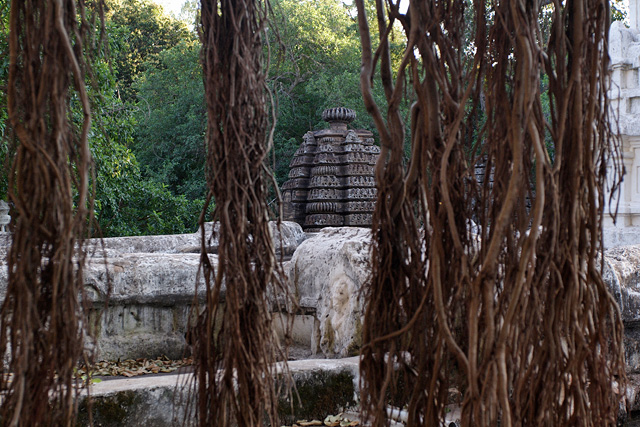
The leafy environs of Mahakuta near Badami
The area around Badami is rich in heritage and strewn with temples that belong to Chalukya era. Excursions from Badami took me first to Mahakoota, a small village dominated by a Chalukyan temple dedicated to Mahakuteshwara. Mahakoota appears like a green island in an ocean of parched land surrounding it. Next to the temple is a sacred grove with thick greenery that creates a cooler local climate that contrasts the scorching weather in the region. The courtyard of the temple is under the shade of large ficus trees. Roots hanging from the trees, temple towers hidden behind the leaves and the silence in the shade bring a calm and soothing feel to the temple surroundings.
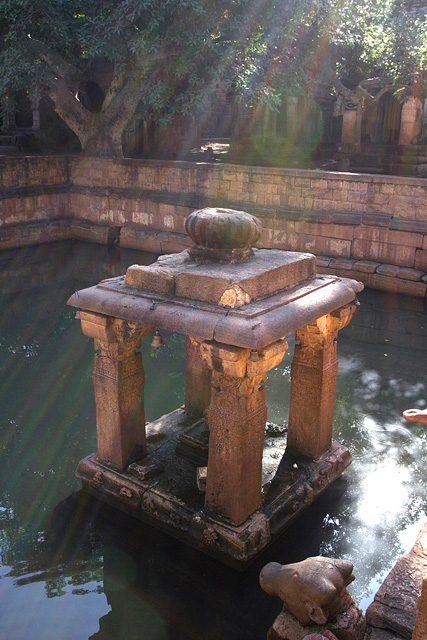
A mantapa at Mahakuta, near Badami
Not far from Mahakuta is Pattadakal, a UNESCO World Heritage Site. The temples here are made of beautiful red sandstone and the carvings have been fading over the years on the external walls due to effect of sunlight. But the interiors appear better preserved. The temples here are a mix of northern Nagar architecture and the Dravidian style of the south.
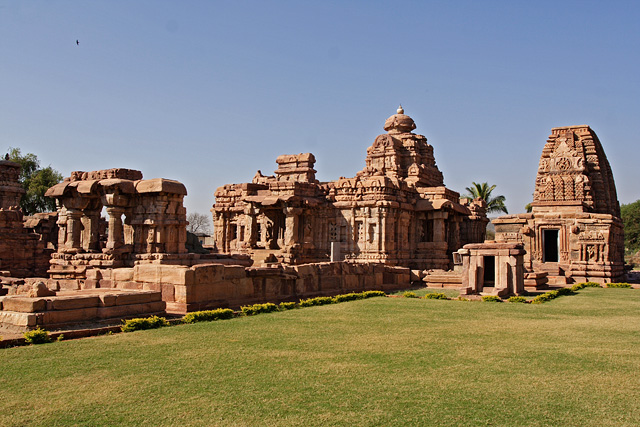
Pattadakal, a UNESCO World Heritage Site near Badami
Further ahead of Pattadakal is Aihole, a village littered with ancient structures that refuse to confirm to any specific style of temple building. With students of those days arriving here from every corner to learn and master the art of carving in stone, historians have often called Aihole as the ‘cradle of Indian architecture.’
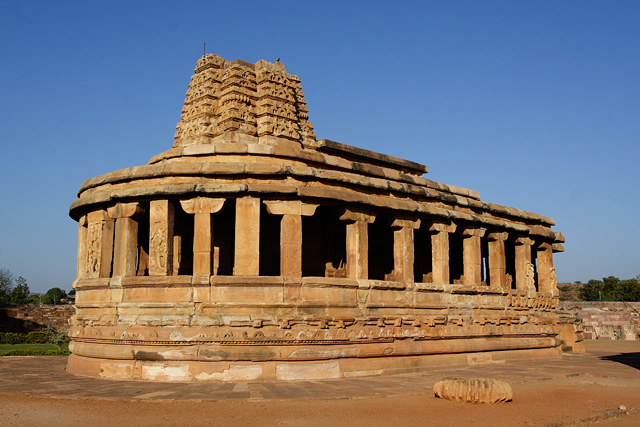
Durgi Gudi, at Aihole near Badami
The first thing that attracts the visitor in Aihole is the well maintained main enclosure of temples in the centre of the village. Taking a tour of the large Lad Khan Temple and well known Durgi Gudi that has parallels with parliament building in its façade, I heard my guide talk about a number of smaller temples spread around the village. Aided by his guidance, I went in search of these ancient structures that seemed to be visited by very few people.
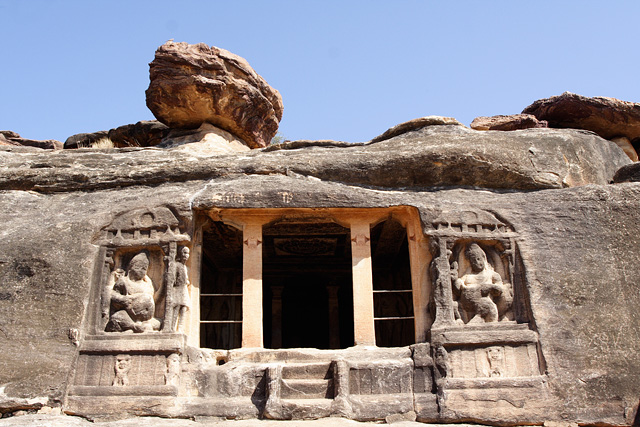
Ravanphadi, a rock cut temple at Aihole near Badami
Among the oldest of these temples is Ravan Phadi, dating back to later half of sixth century. It is a small rock-cut room with a linga in the centre and beautiful carvings on the inner side walls. To the west of Ravanphadi is Huchimalli Temple built in a more formal nagara style of architecture. The temple stands alone in an enclosure far away from other monuments, with its shrine visible from a distance. Seen from anywhere in Aihole is the Meguti Temple located at the top of a hill. Standing next to Meguti Temple, I can see the entire village dotted with ancient temples in all directions and River Malaprabha flowing at the edge of the hamlet.
My visits to Aihole, Badami and its neighbouring heavens of ancient architecture was fuelled by seeing beautiful images of Badami with foaming waters rushing down from its cliffs, as presented in tourist brochures. They were perhaps photographed during the peak monsoon months, but the time when I was there was marked with dry spells. All that I could see was the stains of algae at places where the waterfalls would come alive during the rains. However, the heritage sites in Badami and Pattadakal, the architectural experimentations of Aihole and the calm environs of Mahakoota more than made up for the missing waterfalls. But the appeal of waterfalls now gives me an excuse to plan another tour. As I write this, the monsoons have arrived in most parts of Karnataka and the met department is assuring of good rains for the next few months. It is perhaps time to plan another visit.

